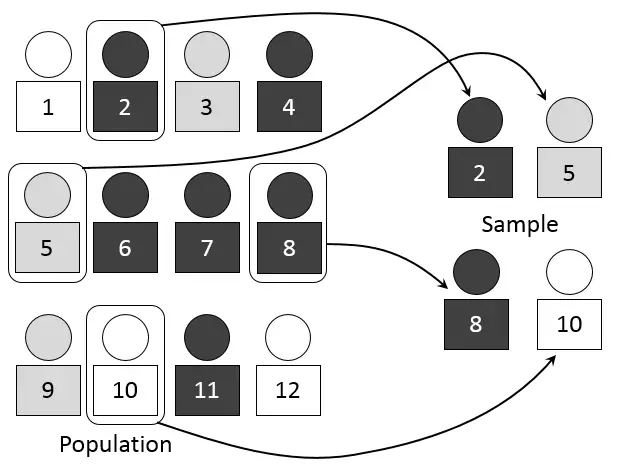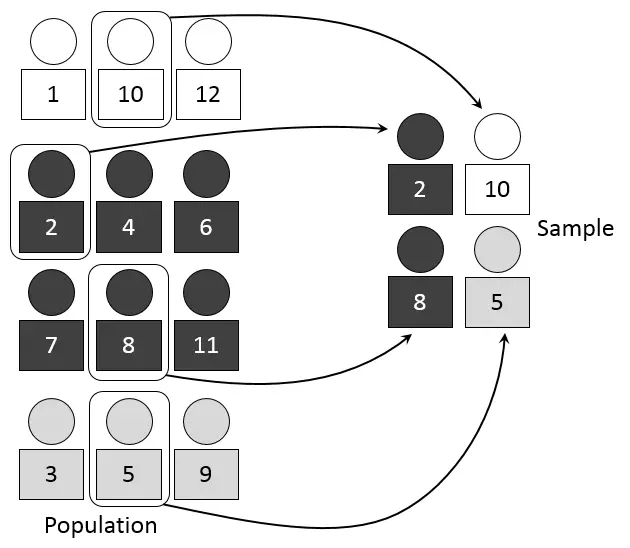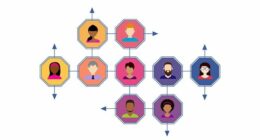Random sampling selects subjects entirely by chance, while stratified sampling divides the population into subgroups and samples from each subgroup proportionally.
TL;DR Random Sampling Vs. Stratified Sampling
Random sampling is often more suitable when the population is homogeneous and there is no need to distinguish between different subgroups. Stratified sampling provides more accurate representation of different subgroups within a population.
Random sampling offers simplicity and ease of implementation but may not always provide an equal representation of all groups within a population. Stratified sampling ensures that each subgroup is represented proportionally but can be more complex to execute.
What is Random Sampling?

Random sampling is a statistical method used to select a subset of individuals or items from a larger population for research or analysis. In this approach, every member of the population has an equal and independent chance of being chosen.
This randomness helps reduce bias and ensures that the selected sample is representative of the entire population, making the results more generalizable.
Random sampling is commonly employed in surveys, experiments, and various research studies to draw valid conclusions and make statistical inferences about the population as a whole. It is a fundamental technique in statistical analysis and hypothesis testing.
What is Stratified Sampling?

Stratified sampling is a sampling method that divides a population into distinct subgroups or strata based on certain characteristics, such as age, gender, or location. Then, a random sample is independently selected from each stratum in proportion to its representation in the overall population.
This approach ensures that each subgroup is adequately represented in the final sample, allowing for more accurate analysis of each stratum and potentially providing insights into how different subgroups within the population differ from one another.
Stratified sampling is especially useful when there are known variations or differences within the population that researchers want to account for in their analysis.
Random Sampling Vs. Stratified Sampling – Key Differences
| Aspect | Random Sampling | Stratified Sampling |
|---|---|---|
| Population Division | No division of the population; each individual or item has an equal chance of being selected. | Population is divided into distinct subgroups (strata) based on specific characteristics or criteria. |
| Selection Process | Selection is entirely random, without considering any specific criteria. | Selection is done independently within each stratum, usually using random sampling within strata. |
| Representativeness | May not guarantee proportional representation of different groups or characteristics within the population. | Ensures that each subgroup (stratum) is represented in the sample in proportion to its presence in the population. |
| Sampling Precision | May not provide precise information about specific subgroups within the population. | Provides more precise information about each subgroup, allowing for subgroup-specific analysis. |
| Suitable for Variability | May not effectively account for known variability or differences within the population. | Particularly useful when there are known variations or differences within the population that need to be considered. |
| Examples | Simple random sampling where each member of a class has an equal chance of being selected for a survey. | Surveying students from different grade levels (strata) separately to ensure representation from each grade level. |
| Statistical Inference | Generally suitable for basic statistical analysis and general population inferences. | Enables more detailed analysis, such as comparing characteristics or trends within subgroups. |
| Complexity | Simpler to implement as it does not involve dividing the population into strata. | Requires more planning and data on strata proportions but offers enhanced representativeness. |
Advantages and Disadvantages of Random Sampling
Advantages of Random Sampling
- Representativeness: Random sampling ensures that each member of the population has an equal chance of being included in the sample. This approach helps create a representative sample, making it more likely that the sample accurately reflects the characteristics of the entire population.
- Reduced Bias: Random sampling minimizes the risk of bias in sample selection. Since selection is entirely by chance, researchers or surveyors cannot intentionally or unintentionally skew the sample toward certain characteristics, reducing potential sources of bias.
- Statistical Inference: Random samples are ideal for making statistical inferences about the population. The principles of probability allow for the application of statistical tests and methods to draw valid conclusions from the sample and generalize them to the larger population.
Disadvantages of Random Sampling
- Underrepresentation of Small Groups: Random sampling may not ensure sufficient representation of small or rare subgroups within the population. It’s possible for some groups or characteristics to be underrepresented by chance.
- Inefficiency: In cases where subgroups vary significantly within the population, random sampling may result in an inefficient use of resources. Researchers may need to collect a larger sample size to ensure sufficient representation of specific subgroups.
- Limited Subgroup Analysis: Random sampling alone may not be suitable for in-depth subgroup analysis. If researchers need to examine differences between specific subgroups, a stratified or purposive sampling approach may be more appropriate.
Advantages and Disadvantages of Stratified Sampling
Advantages of Stratified Sampling
- Improved Representation: Stratified sampling ensures that each subgroup or stratum within the population is represented in the sample in proportion to its presence in the population. This leads to a more accurate representation of the population’s characteristics.
- Enhanced Precision: By dividing the population into subgroups and sampling from each stratum, stratified sampling allows for more precise estimates and analysis within each subgroup. This can lead to more detailed insights and better understanding of variations within the population.
- Effective for Comparisons: Stratified sampling is particularly valuable when researchers want to compare specific subgroups or strata within the population. It allows for direct comparisons between strata, making it easier to identify differences or similarities.
Disadvantages of Stratified Sampling
- Complexity: Stratified sampling is more complex to plan and execute than simple random sampling. It requires knowledge of the population’s characteristics and proportions within each stratum, which may not always be readily available.
- Resource-Intensive: Collecting data from multiple strata can be resource-intensive, especially if the strata are numerous or if there are significant differences in the strata that necessitate larger sample sizes within some groups.
- Potential for Selection Bias: If the population is not properly divided into meaningful strata or if there are errors in stratum proportions, stratified sampling can introduce bias into the sample. Careful planning and accurate data are essential to mitigate this risk.
Image Credits
Featured Image By – The three exhibits to the left were made by EDUCAR@CIA, the exhibit to the right was made by Estes Objethos Atelier, photo by Matemateca, CC BY-SA 4.0 , via Wikimedia Commons
Image 1 By – Dan Kernler, CC BY-SA 4.0 , via Wikimedia Commons
Image 2 By – Dan Kernler, CC BY-SA 4.0 , via Wikimedia Commons









